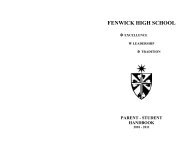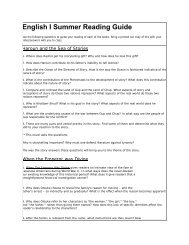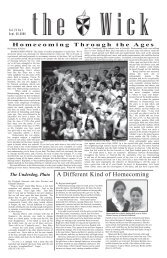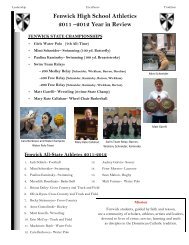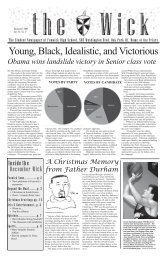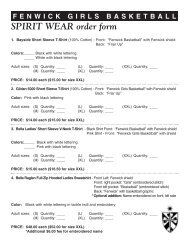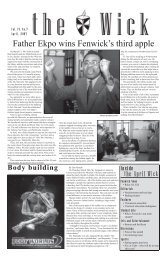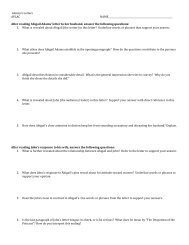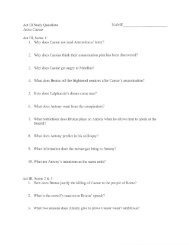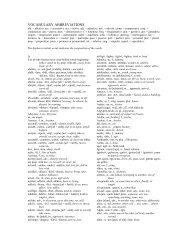Spring 2003 - Fenwick High School
Spring 2003 - Fenwick High School
Spring 2003 - Fenwick High School
- No tags were found...
You also want an ePaper? Increase the reach of your titles
YUMPU automatically turns print PDFs into web optimized ePapers that Google loves.
Secrets of Success<br />
4<br />
SPRING <strong>2003</strong><br />
“ ”<br />
Nothing succeeds like…PRACTICE… INGENUITY.. .PATIENCE… DETERMINATION…<br />
Finish the quote any way you like. Throughout the <strong>Fenwick</strong> community, examples are easy<br />
to find. People who define success in more than a material way.<br />
SEEKING KNOWLEDGE<br />
P<br />
Ramzi has the experience to do the job<br />
well; he’s been coaching JETS and<br />
WYSE (Worldwide Youth in Science<br />
and Engineering) for 23 years. (The two<br />
competitions used to be the same, but<br />
split into separate events in 1996.) The<br />
Friars have enjoyed many successful<br />
seasons, and for the past four years,<br />
<strong>Fenwick</strong> has taken home the WYSE<br />
state championship in Division 1500, in<br />
which more than 300 schools compete.<br />
RACTICE FOR JETS (JUNIOR ENGINEERING AND TECHNICAL SOCIETY) COMPETITION BEGINS IN NOVEMBER. APPROXIMATELY<br />
80 STUDENTS ARE INVOLVED IN ONE WAY OR ANOTHER, AND IT IS UP TO THEIR COACH,RAMZI FARRAN TO TURN THIS YOUNG MASS<br />
OF RAW BRAINPOWER AND EDUCATED ENERGY INTO A COHESIVE AND WELL-PREPARED TEAM.<br />
When competition begins in February,<br />
the WYSE team is tested in seven areas:<br />
math, English, biology, chemistry,<br />
physics, computers, and engineering<br />
graphics. Scores of the test are tallied<br />
and winners are determined in each<br />
category as well as an overall category. In this most recent state<br />
championship, <strong>Fenwick</strong>’s team scored 485 out of a possible 500.<br />
JETS competition takes a different form. As individuals and as a<br />
team, they face the challenge of solving complex engineering<br />
problems. One of the <strong>2003</strong> questions focuses on satellites in orbit:<br />
“Space-based navigation satellites are becoming vital<br />
Dr. Joseph Kerwin ’49<br />
<strong>2003</strong> WYSE individual state champions<br />
(left to right) Damian Kozbur '04, first in physics;<br />
Taso Giannopoulos '03, first in computers; Patrick<br />
Lange '04, first in English; and coach Ramzi Farran.<br />
components to the world’s technological<br />
existence. Your team has been hired<br />
to design a new navigation satellite to<br />
complement the Global Positioning<br />
System (GPS). The satellite has been<br />
allocated an orbital radius, and you are<br />
to investigate various system parameters<br />
to assess the suitability of this<br />
orbital radius.”<br />
Another of this year’s problems was:<br />
“Your team has been tasked with<br />
designing a building to house a laboratory<br />
engaged in critical national<br />
security research in the United States.<br />
Your work will include: selecting one of<br />
three locations, assessing the vulnerability<br />
to natural hazards for each location,<br />
and reflecting knowledge gained in order to reduce the<br />
potential for damage from the impact of natural hazards.”<br />
The months of preparation include researching the subject matter,<br />
and also learning to work together as a problem-solving team.<br />
Finals in JETS competition are scheduled for April 29, (after the<br />
magazine has gone to press). Results will be posted on the web<br />
site: fenwickfriars.com<br />
Seeking Knowledge in Space<br />
Back in the 1930s, there was a young<br />
boy who loved stories about<br />
imaginary space vehicles and<br />
traveling to other planets. In fact, his family<br />
and friends would say, “Look there’s Joey<br />
with his science fiction again; he probably<br />
wants to go to the moon.” And that’s<br />
exactly what he did several decades later.<br />
Dr. Joseph Kerwin ’49 was one of NASA’s<br />
first scientist astronauts – his field of<br />
science being medicine. He made history<br />
aboard Skylab in 1973 when he went<br />
outside the craft to make repairs. During the<br />
Apollo 13 mission, Joe was “capcom”<br />
(short for capsule communication), and it<br />
was his job to communicate instructions to<br />
the crew as they returned to Earth. He also<br />
authored the official report on the 1986<br />
Challenger disaster.<br />
He was with the space program through its<br />
ups and downs. In 1992, when the space<br />
station was facing harsh scrutiny in



